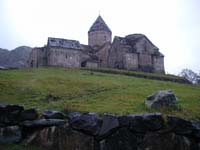|
 |
|
 |
| |
GOSHAVANK |
|
 |
|
 |
| |
Êàòåãîðèÿ: Itineraries |
Íîâîñòü îò: admin | 15.03.2007, 04:56

Near to Dilijan on a high plateau of a picturesque gorge a monastic complex of Goshavank is located. It is perfectly blended with in the nature surrounding it.
The ensemble was constructed on the place of the ancient Getik monastery destroyed in the result of the earthquake of 1188.
The incorporated monastery was originally called New-Getik. But as in its construction the outstanding politician and the scientist of medieval Armenia-Mkhitar Gosh had an active participation, after his death a monastery was renamed into Goshavank. Mkhitar Gosh was the author of the first Code of laws as well. He was also the author of numerous parables and fables.
Goshavank was one of the large centers of medieval culture of Armenia. In its territory worked an Academy - the higher spiritual school which had a legal and historical bias. Here were taught divinity, philosophy, rhetoric, drawing, caligraphy, music. At school studied many famous figures of spiritual culture who then opened schools in other monasteries , continuing their tradition.
The basic churches had identical appearance: from outside they had rectangular form, from within - cruciform. In their corners were located side-chapels. All of them were covered with identical domes.
Church ASTVATSATSIN (TheVirgin) was constructed in 1191-1196. The church originally was wooden, and then it was replaced by stone one.
In 1200-1203 vestibule or Zhamatun was attached to it. Ceiling of the construction is based on 4 columns and 8 semi-columns (located on walls) and arches connecting them. Illumination is provided with a light aperture - yerdik, situated in the center of ceiling.
Nearby there is St. GRIGOR church constructed in 1208. Construction is akin to the main cathedral.
The church LUSAVORICH (Educator) constructed in 1237-1241 is of special interest. The church differs from other constructions of a complex by its magnificent, smart, decorative design of the interior. Walls at an altar twined with graceful vegetative garlands, alternating with geometrical ornament. Columns, the frame of windows and doors were covered with the finest pattern similar to lacy fabric. Facades of church were decorated with graceful arches. On one of the walls sundial was installed.
In the territory of the complex there is a building of the BOOK-REPOSITORY of the BELLTOWER constructed in 1241-1291. It is one of the remarkable monuments of the entire monastic complex. The building was constructed consistently. At first the ground floor was built where the book-repository stood. Only later after 50 years the belltower was erected above it. On the second floor of the building it is possible to go up on console ladders. On the building there are no ornaments. The belltower is as though hovering high into the air. In the building the massive bottom part is articulately separated from the openwork upper one. The ceilings of the belltower are similar to the wooden ceilings of the Armenian national dwellings, however here they are executed in stone.
The Refectory adjoins to a book-repository - belltower. This spacious hall had a wooden covering, which nowadays is not preserved.
Within the confines of the complex there are churches ST. RIPSIME and ST. GEVORG, constructed in 1254. They are slightly distant from the other constructions of complex.
Remains of Mkhitar Gosh were lying on the territory of the monastery. Above the burial place the CHAPEL - MAUSOLEUM of Mkhitar Gosh was erected. Now it is in a dilapidated condition.
CROSS-STONES. In Goshavank fine samples of cross stones are preserved. Especially beautiful cross stones were established at the walls of church Gregory the Illuminator. (One of them now is in the Historical museum of Yerevan city). Cross-stones are covered with a graceful fine ornament. The basic elements of the composition stand out against the background of the precise geometrical pattern - a cross on the shield-shaped rosette in the corners.
Various and highly artistic monuments included in monastic complex relate to an epoch of the heyday of medieval Armenian architecture of XII-XIII of centuries. They are legitimate pride of all Armenian people -the builder.
|
|
 |
|
 |

|
 |
|
| |
Ñ÷¸ò÷èê |
 |
|
| |
| Ïí: |
137 |
| Âò: |
184 |
| Ñð: |
240 |
| ×ò: |
164 |
| Ïò: |
307 |
| Ñá: |
151 |
| Âñ: |
147 |
| Âñåãî: |
550663 |
| Ðåêîðä: |
1604 |
| OnLine: |
9 |
|
 |
|
|

